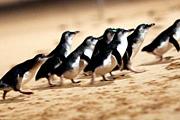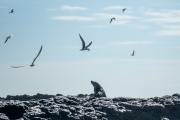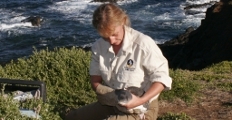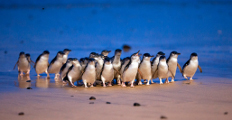Australian first sailing drone ready to explore penguin feeding grounds
Imagine that you could lift off the mirroring surface of the sea and look straight down to the bottom; what would you see? Now imagine that instead, you close your eyes, shout out loud and get a picture of all creatures within milliseconds using the sound. Fitting an echo-sounder or fish finder fitted in a novel sailing drone, we are about to explore what fish is available to Little Penguins from Phillip Island in their foraging grounds.
Finding out how much food is available to penguins is the holy grail to the conservation of their food supply. Changes in food abundance and availability would affect the penguin’s foraging and breeding success.

WHAT
Researchers at Phillip Island Nature Parks and a team of international collaborators will have a clear picture of the underwater world of the Little Penguin, thanks to a new, high-tech, sailing drone funded by the French National Centre for Scientific Research (CNRS), which will help map the penguin foraging grounds for the first time.
The sailing drone will survey the waters off Phillip Island, collecting vital information on water temperature, fish abundance and salinity. It sends sound to the bottom of the ocean, and the echo is translated into images, which will be used by scientists in future research.
The two-metre-long sailing drone, acquired by the lead scientist of the project, Dr Claire Saraux from CNRS, is the result of a partnership between Phillip Island Nature Parks, CNRS, the Swedish University of Agricultural Sciences and the Penguin Foundation. It is fitted with an echo-sounder to give a live picture of what predators and prey lie under the water.
Video: Sailbuoy sailing drone
WHY
Phillip Island Nature Parks’ Marine Scientist Associate Professor Andre Chiaradia said information collected by the sailing drone will be an invaluable asset for penguin research now and future studies into the health of the marine environment around Phillip Island.
“There is a need to improve our knowledge of penguins and other marine species. The sailing drone will give us crucial information for marine spatial planning and conservation,” he said.

Image: Associate Professor Andre Chiaradia
“This is an exciting project for us. It’s technology we haven’t had access to before, and it will change how we manage research and conservation projects for our penguin population.”
“We do not have accurate information on prey composition and availability in the marine systems because direct prey data collection is difficult and expensive, usually requiring research vessels with the prohibitive cost of shipping time.”
The sailing drone sets out to solve these problems. It is an autonomous drone, powered by wind and currents to sail and solar panels to steer and power the sensors.
HOW
Dr Claire Saraux from the French National Centre for Scientific Research is the principal investigator in the sailing drone project.
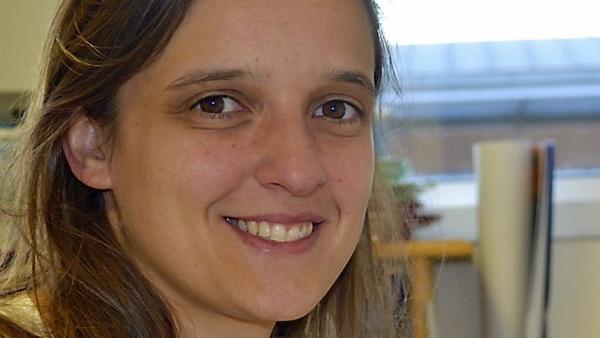
Image: Dr Claire Saraux
“The drone will autonomously collect data during several breeding seasons, giving us insights on environmental variability over time and crucial information to help us manage the food supply of little penguins in the future.” she said.
Associate Professor Jonas Hentati-Sundberg from the Swedish University of Agricultural Sciences is a partner on the project.

Image: Associate Professor Jonas Hentati-Sundberg
“By using green energy, the sailing drone will survey, for the first time, the foraging areas of Little penguins on Phillip Island. The drone is equipped with several high-resolution environmental sensors and will collect data on water temperature, salinity, and chlorophyll,” he said.
French PhD student Lilia Guillet will operate the drone as part of her studies.

Image: The sailing drone trial launch team from left to right: Lilia Guillet, Craig Bester, Jonas Hentati-Sundberg and Andre Chiaradia.
Video: data received from the sailing drone. Like a bat sonar, the drone sends a sound wave that returns as a picture.
“The echo-sounder estimates the quantity of fish available within the water column. The echo-sounder sends out acoustic waves and listens to the reflected sounds from objects with a different density than water, such as fish and the sea floor. The drone will autonomously collect data during several breeding seasons, starting in late 2022, giving us insights on environmental variability over time”, explains Dr Claire Saraux, principal investigator in this project from the French National Centre for Scientific Research.
“Not only will we see the different types of fish under the water, we will also see the quantity of fish. This can help scientists to know what food is available in the foraging zone of little penguins,” Ms Guillet said.
WHEN AND WHERE
The sailing drone will be officially launched on January 20, 2023, in Newhaven on Phillip Island, Victoria. The launch will be attended by the French Ambassador for Australia.
The sailing drone will collect data and information for three years.

Image: sailing drone at sea
WHO
This research will be led by the French National Centre for Scientific Research, in collaboration with Phillip Island Nature Parks and the Swedish University of Agricultural Sciences. It combines the expertise of researchers from all over the world: Dr Claire Saraux and PhD candidate Lilia Guillet, working at the French National Centre for Scientific Research, Associate Professor Jonas Hentati-Sundberg from the Swedish University of Agricultural Sciences, Associate Professor Andre Chiaradia, at Phillip Island Nature Parks. This international collaboration will improve our knowledge of penguins and other marine species, crucial information for marine spatial planning and conservation.
We are grateful for the support for this project from Parks Victoria, Fisheries Victoria and the Cape Woolamai Life Saving Club.
This project It is funded by the French National Agency for Research ANR (project n° ANR-21-CE02-0007).





